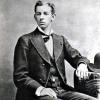The average operating time of an incandescent lamp ranges from 1,000 to 2,000 hours. LED lamps boast a longer "life" - from 25,000 to 50,000 hours, which is why they are gradually replacing traditional incandescent lamps from the lighting market.
But all this is nothing compared to a lonely hanging light bulb in the basement of a California fire department, which has been providing continuous light for 989,000 hours, that is, almost 113 years. Experts from General electrics and physicists around the world have already proclaimed it a source of eternal light.
The question arises: how can this be? Either this is another miracle of nature, or a sign of how little we know about incandescent lamps and that modern copies are not suitable for them. Let's try to figure it out.
A brief history of the light bulb
The laurels of the inventor of the light bulb belong to the notorious Thomas Edison (1879), but it should be said that he was not the only one who tried to create an electric light source.
In 1802, the British chemist Humphry Davy first obtains light by heating thin strips of platinum with an electric current. Over the next 75 years, Davy's experiment served as a kind of basis for the search for other inventors, who also tried to find a way to extract bright and durable light by heating thin strands of one or another metal.
Scottish inventor James Bowman Lindsay was able to obtain a bright light in 1835, which, in his words, allowed him to "read a book at a distance of one and a half feet" - but he soon abandoned experiments in this area to focus entirely on developing wireless telegraphy.
Five years later, a team of British scientists conducted experiments with heating a platinum filament inside a vacuum tube. Despite the fact that platinum is a very expensive metal, and therefore, light bulbs with platinum filament would not be available to everyone, it was the design of this light bulb that formed the basis for the patent of the first electric light bulb in 1841.
American inventor John W. Starr could claim to be the discoverer of the electric light bulb (in 1845 he integrated carbon filaments into an existing lamp design and quite successfully), but the next year he died of tuberculosis, and his colleagues did so and could not bring his undertakings to the end, since they did not possess either knowledge of his level or experience. A few years later, Joseph Swan applied Starr's achievements in his quest and in 1878 was able to assemble the first working prototype of a modern lamp and became the first person to light his home with electricity.
Meanwhile, American inventor Thomas Edison continued to work on improving carbon filaments. By 1880, he managed to extend the life of such a light bulb to 1,200 hours and to establish the production of such bulbs up to 130,000 copies per year.
In the midst of all these events, a man was born, who eventually created the very "eternal" light bulb, which was mentioned in the introductory paragraph.

Adolphe Chaillet was born in 1867 in Paris at the height of the rapid growth of light industry in France. At the age of 11, he started working for the small firm of his father, a Swedish immigrant, in a light bulb company. He studied quickly, became seriously interested in physics and subsequently graduated from the Academy of Sciences in France and Germany. After several years spent designing fibers for a large German energy company, he moved to the United States.
For some time he worked for the already mentioned General Electrics, and then, using his fame as a brilliant electrician and engineer, he managed to find financial support for his own company - Shelby Electric Company. Although Chaie's success in the lamp industry was already widely known, he still needed to prove to the American public from scratch that his products shine brighter and longer. Risking his own reputation, he embarked on a daring experiment: Chaie placed his bulbs and those of a market-leading company side by side, plugged them in and gradually built up the voltage. From this impromptu competition, which he staged in public, Adolf emerged victorious and instantly attracted public attention to his product: they were the only ones left to burn, while the rest simply exploded.
Chaie's success came from his own invention: coiled carbon filaments.
Citing these advances, Shelby said their bulbs last 30% longer and 20% brighter than any other light bulb in the world. The company soon experienced overwhelming success: According to Western Electrician, Shelby Electric Company received so many orders on March 1 that it needed to scale up its plant and work day and night. By the end of this year, they were able to double their lamp production from 2,000 to 4,000 per day.
The advantage of Shelby lamps was so obvious that even the most skeptical of minds were in no doubt.
Over the next decade, the company continued to introduce new products, but after the lighting market expanded significantly and new companies began to use more advanced technologies (tungsten filaments, etc.), Shelby Electric Company did not manage to adapt to the changed conditions and as a result were bought by General Electric, and the production of light bulbs was stopped.
Centenary light
75 years later, in 1972, the chief of the fire department of the California city of Livermore approached a local newspaper with a report that shocked everyone: he found a lonely hanging Shelby light bulb in the basement of a fire department, which had been working continuously for decades. Firefighters themselves have long treated this light bulb as a kind of legend, a local landmark, but no one knew for certain how long this light was already on and where it came from at all. Mike Dunstan, a young reporter for the Tri-Valley Herald, took to investigating the details of the story and what he eventually unearthed was equally interesting and exciting.
After tracing the history of this light bulb through dozens of oral stories and written evidence, Dunsten determined that the light bulb was purchased in the late 1890s by a certain Dennis Bernal, who at that time owned the first energy company in the city - Livermore Power and Water Co. Following the sale of the company, Dennis donated this bulb to the local fire department. Now this sounds a bit comical, but remember that at that time, only 3% of all homes in the United States were lit with electricity, and light bulbs were a real hot commodity.
For several months at first, the light bulb simply lay in the basket where the firefighting equipment was kept. Then she was hanged in the building of the city hall, but she did not stay there for long and returned to the fire station again. Since then, according to the current chief of the fire department, this light was very rarely extinguished, except during the period when the fire department was rebuilt: then all electricity was turned off for a week. It happened that the light was turned off several times, and in 1976 the light bulb was completely transported to the new building of the fire station. It sounds incredible at all, but a whole crowd of people watched the process of re-installing the lamp. At some point, it seemed that the light bulb had burned out, but the electricians turned the switches, and it again illuminated the whole neighborhood with a bright light.
In the room where the light bulb was placed, video surveillance was carried out to make sure that the lamp would not go out over time and if it was able to work uninterruptedly for a whole day. Even then, it was treated as a miracle, but after the craftsmen organized an online broadcast and everyone and everyone began to observe the work of the light bulb, it turned into a cult.
At some point, the lamp went out and everyone decided that this was the end of the story, but after 9.5 hours it turned out that it was not the lamp that had burned out, but the wiring. The wires were replaced and the light turned on again. As a result, this Shelby legend was able to survive not only the wiring, but also three CCTV cameras.
This legendary light bulb shines to this day, but, according to eyewitnesses, it gives very little light: only 4 watts. However, the entire fire brigade treats this tiny glass ball like a porcelain doll. “Nobody wants the light to go out,” former fire chief Gary Stewart once said. "If that happens, it won't be a very good end to my career."
They don't do them the way they used to.
The longevity of this light bulb aroused the interest of many, and everyone tried to uncover the secret of this device. The fire department even came from the famous TV show "Mythbusters", but the answer was never found.
Some, like David Tse, professor of electrical engineering at the University of California at Berkeley, are more skeptical and consider the whole story of the eternal light bulb absurd. Others, like engineering student Henry Slonsky, on the other hand, are convinced of the truth of the story and explain such a long lamp life by the fact that things were done better in those days.
In 2007, physics professor Debora M. Katz from Annapolis purchased a similar light bulb that hangs in the fire department and conducted a series of experiments trying to find out what makes it different from modern lamps and explains such an enviable longevity.
The first thing she noticed was the thread width. But it turned out that in both modern lamps and Shelby lamps, the filament width is approximately the same and is 0.08 mm.
Then the professor suggested that the whole point is not in the width of the thread, but in its density: according to this indicator, Shelby bulbs exceeded modern ones by 8 times. Current designs use thinner tungsten filaments that provide more light and heat (40 to 200 watts). Deborah explains: “Imagine an animal with a slow metabolism. This is the Shelby light bulb. It gives less light, but lasts much longer. " Katz also does not exclude that the fact that the light bulb was rarely turned off may be the reason for the longevity. The on-off process has a negative impact on any mechanism, it wears out.
What does the industry think?
The average life of a modern incandescent lamp is 1,500 hours. LED bulbs last longer - 30,000 hours, but are therefore more expensive. The Shelby light bulb has been shining for 113 years, or about a million hours. Where could the manufacturers be mistaken that they shortened the working period of the device so much? Or maybe it was done on purpose?
The fact is that in the days when the Shelby Electric Company took off, marketing was focused on the durability of the product. That is why the Chaier company was so proud of the excellent quality of their products. But at the beginning of the 20th century, the emphasis in marketing shifts to the opposite pole and a completely different rhetoric begins to dominate, which should sound quite familiar to us: a product that does not wear out threatens business with collapse and bankruptcy. This idea was developed in the deliberate, planned obsolescence of the product, when the manufacturer deliberately shortens the life of the product, stimulating repeat sales.
In 1924, such large international companies as Osram, General Electric, Philips and several other companies founded the so-called Phoebus Cartel, an organization that set the standards for the production of light bulbs. But that was the public version. In fact, these companies have tackled the planned obsolescence problem. As a result, the duration of the light bulb was reduced to 1,000 hours (although Edison reached 1,200 hours a decade ago), and anyone who introduced products that did not meet these standards could be fined.
This continued until the beginning of the Second World War. But for 20 years, this organization could easily have hindered research into more durable lamps.
Conclusion
There is no evidence to suggest that modern light bulb manufacturers are deliberately making inferior products, so the issue of planned obsolescence is highly controversial today.
One way or another, but the volume of production of traditional incandescent lamps is declining all over the world. More efficient now are halogen lamps, LED, compact fluorescent lamps, magnetic induction headlights. But not one of them is still close to the record of the light bulb that still hangs in the basement of the fire department and refuses to go out.
It deservedly bears the title of the oldest light bulb in the world, because it has been burning for more than a century. To be precise, 117 years old. The service life of a conventional incandescent lamp does not exceed 2000 hours, while modern LED lamps have a margin of safety several times greater, reaching 50 thousand hours. But 1 million 25 hours is an absolute record and far from the limit. What's the secret?
A bit of history
The world's oldest light bulb was invented by Thomas Edison. This happened in 1879, when he conducted experiments to improve the carbon filaments.
Edison worked for almost a year - he managed to increase the resource to 1200 hours, after which the serial production of lighting devices began.
At the time, the Parisian Shaie was only 11 years old. His childhood and adolescence fell on a period when the popularity of lighting was growing rapidly. Chaie's father owned a small incandescent lamp company, and his son, who took a keen interest in the products, decided to connect his life with physics.
Science interested him as a foundation for creating a light bulb that burns for 100 years, and the opportunity to make good money on the invention. Shaie studied in parallel at the German and French academies, and after graduation he worked in a large profile company in Germany.

Then he moved to America and opened his own production. Shaie's factory was called the Shelby Electric Company.
Public experiment
The physicist and the inventor succeeded in their plans. In 1897, Shelby Electric announced that their products were 20% brighter than competitors and had nearly a third more resource.

During testing, incandescent lamps from different manufacturers were installed side by side and connected to the same electrical network. Then the voltage began to rise smoothly. One after another the lamps burned out and exploded. A few minutes after the start of the experiment, the laboratory was illuminated only by Shelby devices. Not a single lamp is out of order.
As soon as the article came out, the company received double the usual orders - employees had to work at night to complete them. The issue continued actively for the next decade, after which things began to decline.
The owner of the company did not want to modernize production, as a result of which Shelby could not compete with other firms. In 1914, she stopped the production of lamps.
Lamp from Livermore
The 100-year-old light bulb, as it is popularly called, is one of those produced by Shelby Electric. In 1901, it was bought and turned on for the first time. But she became famous much later.
In 1972, a California newspaper ran a curious story. According to the head of the fire inspection Livermore, they have an unusual light bulb in the room that has been continuously lit for several decades. Firefighters wrote legends about it, but no one knew when it was lit.

Young proactive reporter Mike Dunstan, having heard an unusual story, decided to investigate on his own. He found dozens of eyewitnesses, collected their written and oral memories and reconstructed the history of the longest light bulb in the world.
Dunstan discovered that the legendary model was bought by Dennis Bernal and the seller was Livermore's first energy company. It happened at the end of the 19th century - the journalist could not establish the exact year.
Then the lamp illuminated the garage, the mayor's office, and in 1901 it got into the city fire department. It burned around the clock at low power - only 4 watts, used as night lighting. Operating conditions - deep underflow and low efficiency.
The legendary lamp was turned off only 2-3 times. The last time was 22 minutes in 1976. Before that, it did not burn for almost a week, when in the 30s of the last century, reconstruction took place in the fire station.
A light bulb that has been burning for 100 years is a city landmark, everyone can watch it online. Recently, a webcam has been installed in the fire department and is aimed at a unique device. Representatives of the Guinness Book of Records, determined her age and determined that she is the oldest in the world.

An ordinary light bulb glorified the unremarkable town of Liverme. Tens of thousands of people watch it online, thousands come to see the unique ceiling lamp that burns and does not go out. Firefighters are happy to organize excursions to her.
In 2001, local residents celebrated the 100th anniversary of the light bulb. The celebration included barbecues, contests and live music. Musical accompaniment was provided by three ensembles at once.
What's next?
The firefighters are not going to change the popular light bulb that made their station and city famous. But even when it burns out, it will not go to the trash. Several museums want to immortalize the electrical long-liver in their exhibits. The first in line is the Ripley Museum.
What is the secret of such an impressive service life? Physicists have not figured it out.
In the United States of America, the average incandescent lamp (that is, the one heated by a wire filament) has a lifespan of about 1000 to 2000 hours. The operating time of light-emitting diode (LED) lamps, which are now increasingly replacing incandescent lamps, is said to be between 25,000 and 50,000 hours - an incredible difference.
But the lamp hanging from the ceiling of the California fire department burned for 989,000 hours - almost 113 years. Since its installation in 1901, it has rarely been shut down and has survived the many firefighters who have worked here for an entire era. For this, experts from General Electric and physicists around the world have called her "the eternal light."
Tracing the history of this light bulb, known as the Centennial Light or "Centennial Light," has led scientists to wonder if it is one of the wonders of physics or a sign that modern light bulbs are much weaker than their predecessors. The longevity of her work is still a mystery.
A brief history of the light bulb

Although it is generally accepted to say that Thomas Edison "invented" the first light bulb in 1879, it was preceded by the experiments of many other inventors.
In 1802, British chemist Gamphrey Davy created an incandescent lamp by passing current through thin strips of platinum. Over the next 75 years, his experiments served as the basis for many developments aimed at creating long-lasting, brightly glowing lamps based on heated incandescent filaments. Scottish inventor James Bowman Lindsay bragged about his new light bulb in 1835, allowing him to “read a book at a distance of one and a half meters,” but soon gave up his efforts to focus on wireless telegraphy. Five years later, a group of British scientists experimented with platinum filaments inside a vacuum tube. Although the high price of platinum made their device inaccessible and difficult to manufacture on a large scale, this design formed the basis for the first filament lamp patent, issued in 1841.
The American inventor John W. Starr, thanks to his introduction to the use of carbon filaments in 1845, could possibly have received the title of inventor of the first light bulb, but died of tuberculosis the next year after its discovery, and his colleagues could not continue the scientist's work without his knowledge. and experience. A few years later, British physicist Joseph Swann used Starr's achievement to produce the first work lamp, and in 1878 became the first person in the world to decorate his home with incandescent light bulbs.
Meanwhile, in America, Thomas Edison was working to improve carbon filaments. By 1880, through the use of a higher vacuum and the development of a full-fledged integrated electric lighting system, he had improved the duration of his light bulb to 1,200 hours and began producing his invention at a rate of 130,000 light bulbs per year.
In the midst of this innovation, a man was born who managed to create the most durable light bulb in the world.
The Shelby Electric Company

Adolphe Scheie was born to create the most unique light bulb. Born in 1867, Chaillet was constantly influenced by the growing lamp industry in Paris, France. At the age of 11, he decided to make his own money, and therefore began to accompany his father, a Swedish immigrant and the owner of a small company that manufactures incandescent lamps. He quickly studied, showing an interest in physics, and graduated from two academies of sciences at once - the German and the French. In 1896, after spending some time designing filament for a large German energy company, Shaie moved to the United States.
Shaie worked for General Electric for some time, but then, thanks to his authority as a brilliant electrician, managed to get $ 100,000 (which is equivalent to $ 2,750,000 in 2014) from investors and opened his own factory for the production of Shelby Electric Company lamps. While his advances in incandescent technology were well known, Chaier also wanted to prove to the American public that his lamps were the brightest and most durable of any kind.
Taking a risky maneuver, he decided to conduct a public test of the life of his lamps: popular bulbs were placed side-by-side with his merchandise and all were connected to a gradually increasing voltage source. An 1897 issue of Western Electrician recounted what happened next:
"Lamp after lamp of various brands burned out and exploded until the laboratory was left illuminated only by Shelby lamps - none of them was noticeably damaged even with extreme stress during such a visual test."

Shaye's original patent
According to The Electrical Review (1902), the brightness of the bulbs was attributed to Shaya's patented spiral carbon filament:
“It was practically pointed out that the main idea of the inventor was to align the turns of the spiral, as well as the bottom of the lamp, so that the greatest intensity of light was emitted downward. The thread was wound in the form of a loop elongated in the transverse direction from the axis of the lamp, or, in other words, an elliptical loop, the main axis of which was transverse to the longitudinal axis of the lamp. The lamp body was likewise flattened at its upper end so that its glass wall was substantially parallel to the lower filament hinge lines when the lamp was suspended from the ceiling. "
Citing such achievements, Shelby stated that his bulbs last 30% more and burn 20% brighter than any other lamp in the world. His company experienced explosive success: according to Western Electrician magazine, they "received so many orders on March 1 that they had to work all night long and dramatically increase the size of the plant." By the end of the year, the company's productivity had doubled from 2,000 to 4,000 lamps a day, and "the benefits of using Shelby lamps were so obvious that they certainly did not go unnoticed even among the most skeptical of consumers."
Over the next decade, Shelby continued to release new products, but as the light bulb market expanded significantly and new technologies (tungsten filaments) emerged, the company was unable to make the large cash investments needed to keep the market competitive. In 1914, they were bought out by General Electric, and the production of Shelby bulbs was discontinued.
The centennial light

Seventy-five years later, in 1972, the chief of the fire department in Livermore, California, told a local newspaper a strange thing: a naked Shelby light bulb hanging from the ceiling of his station had been on continuously for decades. Truth be told, she had long been a legend in the fire department, but no one knew for sure how long it burned or where it came from. Mike Dunstan, a young reporter for the Tri-Valley Herald, investigated the matter and what he found was truly impressive.
Tracing the light bulb's history through dozens of oral and written stories, Dunstan determined that it was acquired by Dennis Bernal from the Livermore Power and Water Co. (the city's first energy company) around the end of the 1890s and then transferred to the city's fire department in 1901, after Bernal sold the company. And since only 3% of American homes were lit with electricity at the time, Shelby bulbs were a hot commodity.
In its early years, the light bulb known as the Centennial Light or "Centennial Light" was moved only a few times: it hung in the fire department's premises for several months, and then, after a brief stay in the garage and city hall, was moved to the Livermore fire station. “It stayed on 24 hours a day to light a dark path for company employees,” said Jack Baird, then-fire chief, Dunstan. “It's part of a different era for the city and it still does its job very well.”
Although Byrd admitted that it was still turned off once "for about a week when the public works department, created by Roosevelt, reconstructed the fire station in the 1930s," representatives of the Guinness Book of Records still established that the hand-blown lamp the 30-watt reached a 71-year line of operation and was "the world's oldest incandescent light bulb." This announcement was followed by an immediate press response.
In addition to the reconstruction of the fire station in 1930, the light was turned off a couple of times - in 1976, when it was brought to the new fire station of Livermore No. 6. Accompanied by an "escort of many police and fire trucks," a crowd eager to see it re-ignite, but as deputy fire chief Tom Braendall recalls, "there was one frightening moment."
“We got to a new place, the city electrician installed a light bulb and plugged it in. It took about 22-23 minutes, and the light still did not light up. The crowd looked at her with bated breath. The city electrician grabbed the switch, shook it and it finally worked! "
After it was installed, they began to conduct video surveillance behind the lamp to make sure that the latter really burned without interruption. In the following years, an online camera called "BulbCam" appeared on the Internet, showing the operation of the lamp in real time. Last year, fans of the light bulb (of which there are almost 9000 people on Facebook) got terrified when it stopped glowing.

At first it looked like she had finally finished her job, but after nine and a half hours, it was discovered that the bulb's uninterruptible power supplies had failed. As soon as their work was restored, the light bulb began to illuminate the room again. Thus, the 113-year-old incandescent lamp outlived its power supply (however, it also outlived three CCTV cameras).
The lamp is still shining today, although one retired volunteer firefighter once said that “it doesn’t give much light anymore” (only about 4 watts). But the owners of a fragile piece of history treat it with great responsibility: Livermore firefighters take care of a small light bulb like a porcelain doll. “Nobody wants this light bulb to go out of order in front of their eyes,” former fire chief Stuart Gary once said. "If she broke while I was still in charge, it would not have a very good impact on my career."
They don't behave as usual.

Everyone from MythBusters to National Public Radio has put forward their own explanations for the longevity of the Shelby bulb. But, in general, there is only one answer - a complete mystery, because the Shaie patent left most of the process unexplained.
Some, like UC Berkeley professor of electrical engineering, David Tse, openly question the bulb's authenticity. “It's not possible,” he told the Chronicle in 2011. - It's a joke". Others, like engineering student Henry Slonsky, argue that this is most likely due to the fact that once all things were done with a huge margin of safety, it is not possible today. "At the time," he says, "people were making everything much more durable than required."
In 2007, Annapolis physics professor Deborah M. Katz bought an old Shelby light bulb from the same year as the Centennial Light and ran a series of experiments on it to determine its main differences from modern lamps. In her findings, she reported that:
“I noticed the width of the filament by comparing it to the width of today's lamp filament. It turns out that the thread of modern lamps is a coil with a diameter of about 0.08 mm, twisted from a wire about 0.01 mm thick. I didn't know it until I looked under a microscope: the width of a 100-year-old filament of a Shelby lamp is about the same as the width of a spiral filament of a modern light bulb - 0.08 mm. "
While Katz's findings are inconclusive, she suggests that the fact that the filament of a Shelby light bulb is eight times thicker than that of a modern light bulb may be the secret to its longevity. According to her, modern lamps use thinner tungsten filaments, which give more light (from 40 to 200 watts) and burn harder, which is why they feel more voltage than older bulbs of the type that Shelby invented. “You can think of it as a low-metabolic animal,” she told Centennial Light's overseers. "This feature allows her to spend less energy, and therefore she can continue to work longer than others." Katz also adds that the long-term operation of the light bulb, in particular, was facilitated by the fact that it was not turned off, as it is done in ordinary life, because this process wastes the energy of the light bulb more than if it was allowed to work continuously (the filament must be warmed up every time, just like a car engine).



Shelby light bulb properties (according to Justin Felgar)
Justin Felgar, one of Dr. Katz's students, studied the light bulb further and published his 2010 work entitled Centennial Filament. In it, Felgar writes that he was able to figure out one curious pattern: the more the Shelby lamp heats up, the more electricity passes through the Centennial Light filament (and this is the exact opposite of what happens with modern tungsten filaments). Felgar argues that in order to determine the exact cause of the incandescence of the Shelby lamp filaments, it would be necessary to "tear off one piece" and pass it through a particle accelerator at the Naval Academy, but this is a very expensive process, and therefore it still remains not verified.
Ultimately, Katz and her colleagues never have an exact explanation for this mystery. “I thought that for sure all physical processes should eventually end,” she says. "But perhaps something accidental happened to this particular light bulb." The former deputy chief of fire department Livermore agrees with her. “The reality is that this is probably just another mistake of nature,” he told NPR reporters in 2003, “only one in a million bulbs can continue to glow like this year after year.”
Lamp cartel

Today, the average incandescent light bulb lasts about 1,500 hours, while premium LED bulbs ($ 25 each) emit light for about 30,000 hours. Whether the 100-year-old light bulb had a secret formula to work or not, it burned for 113 years - that is, about 1 million hours. So why can't we create the exact same durable light bulb?
Lamp companies such as The Shelby Electric Company prided themselves on the long life of their products, so much so that the durability of their products has consistently been the focus of their marketing campaigns. But by the mid-1920s, the way of doing business had changed somewhat and a new rule began to prevail:
"Products that don't wear out are a tragedy for business." This line of thought is called “planned obsolescence,” in which manufacturers deliberately shorten the life of their products, resulting in faster replacement.
In 1921, the multinational light bulb manufacturer Osram formed the Internationale Glühlampen Preisvereinigung (International Light Bulb Pricing Association) to regulate prices and restrict competition. General Electric soon responded by founding General Electric International Company in Paris. traded patents and sales information to strengthen their position in the lamp market.
In 1924, Osram, Philips, General Electric, and other large electric utilities met and formed the Phoebus cartel under the guise of a joint collaboration, ostensibly to standardize light bulbs. Instead, they began to tackle planned obsolescence. To achieve the latter, the companies agreed to limit the lifespan of light bulbs by 1000 hours - less than even the lifespan of Edison's lamps (1200 hours). Any company that makes a light bulb that lasts more than 1000 hours will be fined.
Prior to its disbandment during World War II, the cartel allegedly halted all research into longer-lasting light bulbs for twenty years.
Regardless of whether planned obsolescence is still on the agenda for light bulb manufacturers, it is highly controversial and there is no hard evidence that all of this has happened (or is happening). In any case, the production of incandescent lamps is gradually declining around the world: this trend began to be seen in Brazil and Venezuela in 2005, and many countries have followed suit (the European Union, Switzerland and Australia sharply reduced the production of such lamps in 2009, Argentina and Russia - in 2012, and the United States, Canada, Mexico, Malaysia, and South Korea in 2014).
As soon as more efficient technologies appeared (halogen, LED, compact fluorescent lamps, magnetic induction lamps), the old lamps with incandescent filaments became a relic of the past. But the incredibly old light bulb hanging from the white ceiling of Livermore Fire Station # 6 is more relevant than ever and still refuses to fail.
The material was prepared by Natalya Zakalyk - according to an article from the site priceonomics.com
Are you going to make a renovation? Do you want a beautiful mosaic for your bath? Do the prices bite? Then your choice is to buy an inexpensive bathroom mosaic. It's not cheap anyway, but worth it.
P.S. My name is Alexander. This is my personal, independent project. I am very glad if you liked the article. Want to help the site? Just check out the ads below for what you recently searched for.
Copyright site © - This news belongs to the site, and is the intellectual property of the blog, is protected by copyright law and cannot be used anywhere without an active link to the source. Read more - "About Authorship"
Are you looking for this? Perhaps this is something that you have not been able to find for so long?
Edison's oldest non-burning incandescent light bulb is 116 years old!
Amazingly, it was turned on back in 1901, when the first aircraft in history had not yet taken off, and since then it has never stopped working. This unique American landmark has been located in the fire department of the California city of Livermore for over a century.
She, as you might guess, is listed in the Guinness Book of Records. It happened in 1972, shortly after local reporter Mike Dunstan heard from the station staff about the unusual longevity of the old lamp.
The "centennial lamp", as it is commonly called in the United States, even has its own official website (centennialbulb.org), on the main page of which you can contemplate an online broadcast of an amazing light source. A webcam installed specifically for this purpose transmits a photo of a light bulb to the Internet every few minutes. Every day hundreds of curious people visit this resource hoping to see that the "centenary lamp" has finally gone out (why do they need it?), But this has not happened so far.
The webcam was installed here in 2010, and since then it has managed to break twice, but the amazing lamp is timeless.

The miracle device was made by hand in the 1890s by the American Shelby Electric Company. The glass for the 60-watt light bulb was blown in the traditional way. Its carbon filament, which is 8 times thicker than the spirals of modern lamps of this type, was created using the technology of Thomas Edison, but under the auspices of Adolph Scheie, a direct competitor of Edison.
The secret to the longevity of the "centenary lamp"
The unusually high resource of the old woman is explained by the fact that in those days the manufacturers worked conscientiously and created durable lamps, that is, they strove for this, not yet focusing on the sophisticated deceptive needs of the market.
It's no secret that today industrialists practice the so-called, that is, they produce any products, including light bulbs, with a deliberately short service life, so that they fail as soon as possible, and customers ran to stores for replacement. By the way, it was incandescent light bulbs that became the first product that they began to specifically make insufficiently high-quality for long-term operation. To this end, at one time, manufacturers of incandescent lamps even gathered at an international council, where they agreed to reduce the service life of Edison's lamp to a certain (relatively small compared to the previous period) number of hours. And only the USSR at that time did not participate in this deal of the century, which is why Ilyich's light bulb was practically non-combustible for a long time (the older generation born in the USSR still remembers this well).

The secret of the longevity of the "hundred-year-old lamp" also lies in the fact that it is never extinguished, that is, there are simply no off-on cycles. Namely, they, as you know, most often lead to burnout of incandescent bulbs.
And finally, although the lamp in Livermore originally worked with a given power of 60 watts, today this figure is only 4 watts, which, you see, is extremely small for effective lighting, but economical in terms of the longevity of the lighting fixture.
In 2001, firefighters celebrated the centenary of America's Little Pride. At the same time, a kind of "committee of a hundred-year-old light bulb" was created, dealing with the issue of preserving its working capacity for as long as possible - at any cost. It would be better, of course, if the manufacturers of modern light bulbs also took care of the durability of their products ...
Some things made in time immemorial are surprising in their durability. In turning factories, you can still find machine tools produced in the second half of the 19th century, when the first electricity appeared. They require a transformer, but they can still be used for their intended purpose for simple tasks. It is mistakenly believed that the main long-livers in this area relate only to mechanics, but there are also quite functional devices that have survived to this day. One of the most striking examples is the so-called centenary lamp, which has been burning almost continuously, being interrupted by emergency blackouts, since 1901. It was first screwed into the cartridge in 1901. Since then, it has never been withdrawn for revision of the base and contact parts. She has her own website and broadcast on the worldwide network.
A bit of history
Initially, the device had a relatively low power, experts call different numbers based on exact copies of this product. This is about 50 to 60 watts, it shone quite brightly. It was made by hand, the flask was made by glass blowers, and the incandescent body was rolled by workers on a special machine in Shelby, USA. The date of manufacture dates back to around 1890. The lamp remained in the warehouse for 11 years before it was screwed into place, because the number of consumers in those days was extremely small.
This device first came across in the press in 1972, when a local journalist heard of its existence. He first wrote in a local newspaper, but at the same time turned to the Guinness Book of Records. He personally made an appointment with the CEO of General Electric to talk about the phenomenon. Record experts have indeed confirmed the age of the device. She survived many travels and even a small fire, but at the same time, all the workers carefully kept the relic. It is even forbidden to twist it out of the cartridge, so as not to provoke extinction.
There were interruptions in work, but all of them were connected with shutdowns due to accidents on the lines. In 2013, the press exploded with reports that the lamp had gone out, but that it was simply the uninterruptible power supply cut off. When the webcam appeared, there were rumors about the replacement of the device, but this was not confirmed. Now the fire department of the city of Livermore maintains burning around the clock until a complete failure occurs.

Doubles and falsifications
The appearance of the lamp has been recreated in various copies sold as the original. The scammers said that it was just a lucky batch, that all the lamps produced that year were so durable. The cost was really impressive, because it was extremely difficult to check the product for originality. As a result, buyers treated such statements as another attempt to sell a souvenir, and it never came to serious auctions.
Modern manufacturers don't try
Conspiracy theorists often cite this lighting fixture as direct evidence that current factories deliberately underestimate their resource by installing ultra-thin coils in incandescent bulbs. This is partly true, but with such a thick body of heat in a modern power grid, everything will burn out quickly enough from powerful overheating. The glow occurs in a warm spectrum, which indicates a relatively low temperature. Therefore, the secret of durability is beyond doubt. If you heat everything up to white heat, then it is not known how long the lamp will last. And in the age of constantly developing technologies, it is stupid to talk about such service life. Your neighbors will buy more economical and colorful models, and you will use an outdated and outdated device.

Not a hundred years, but a very long time
We cannot offer such lamps, because modern manufacturers do not produce them. But in the online store "ProfElectro" you have access to the best progressive LED technologies that allow you to illuminate any room. These are the most durable bulbs that function reliably for 5 years or more. This is a useful purchase that allows you to significantly reduce your energy costs.














